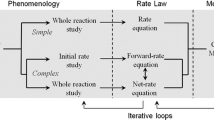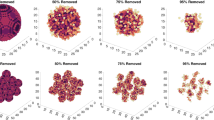Abstract
The cubic equation recently derived for the increase in concentration of a solute with time, as the solid dissolves in batch according to the shrinking sphere model at high under-saturation, is extended to dissolutions of mixtures of differently sized particles. This problem needs to be solved if batch dissolutions are to play their part in the proposed amelioration of global warming and associated climate change by accelerated ‘re-burial’ of excess CO2 in ocean sediment. The upgraded model was tested using sodium chloride dissolved in 50% aqueous propanone, whence the model fitted two separate runs with 500 and 212 μm, and 212 and 38 μm, diameter crystals, respectively. The key to simulating dissolution in this way lies in the dissolutions being independent of each other. It is further shown that although this condition was implicit in the recent derivation of the cubic equation, it was not recognised at the time. The work should be applicable to any batch dissolution of mixed particles at high under-saturation, and hence, may find use in many industrial and laboratory dissolutions. Simulations show how agglomerated mixtures can yield a straight line on the plot of ln(1 − C/C T) versus time, as was reported to occur recently with sodium chloride taken ‘straight from the bottle’. It is shown that this probably explains why exponential dissolutions may have seemed appropriate to the dissolution of biogenic silica in earlier literature. This study suggests that a new round of biogenic silica dissolutions, but with sieved samples, would be worthwhile, with the likelihood that shrinking sphere behaviour might well be found to characterise the kinetics. The opportunity is taken to investigate a number of aspects of the shrinking sphere model not generally discussed before, e.g. the graph for the change in surface area with time. The limitations of using cubic salt crystals with the shrinking sphere model are discussed.





Similar content being viewed by others
References
Balbach S, Korn C (2004) Pharmaceutical evaluation of early development candidates—the 100 mg-approach. Int J Pharm 275:1–12. doi:10.1016/j.ijpharm.2004.01.034
Bunnett JF (1974) From kinetic data to reaction mechanism. In: Lewis ES (ed) Techniques of chemistry vol VI: Investigation of rates and mechanisms of reactions (part 1). Wiley-Interscience, New York, pp 367–488
Gananadesikan A (1999) A global model of silicon cycling: sensitivity to eddy parameterisation and dissolution. Glob Biogeochem Cycles 13:199–220. doi:10.1029/1998GB900013
Greenwood JE, Truesdale VW, Rendell AR (2001) Biogenic silica dissolution in seawater-in vitro chemical kinetics. Prog Oceanogr 48:1–23. doi:10.1016/S0079-6611(00)00046-X
Heinze C, Maier-Reimer E, Winguth AME, Archer D (1999) A global oceanic sediment model for long-term climate studies. Glob Biogeochem Cycles 13:221–250. doi:10.1029/98GB02812
Hubbard ML, Riley JP (1984) Kinetic studies of the rate of dissolution of silica and diatom tests in sea water. J Oceanogr Soc Jpn 40:148–154. doi:10.1007/BF02302495
Hurd DC (1983) Physical and chemical properties of siliceaous skeletons. In: Aston SR (ed) Silicon geochemistry and biogeochemistry, Chapter 6. Academic Press, London, pp 187–244
Hurd DC, Birdwhistell S (1983) On producing a more general model for biogenic silica dissolution. Am J Sci 283:1–28
Jiang M-S, Chai F, Dugdale RC, Wilkerson FP, Peng T-H, Barber RT (2003) A nitrate and silicate budget in the equatorial Pacific Ocean: a coupled physical-biological model study. Deep Sea Res Part II Top Stud Oceanogr 50:2971–2996. doi:10.1016/j.dsr2.2003.07.006
Kamatani A (1982) Dissolution rates of silica from diatoms decomposing at various temperatures. Mar Biol (Berl) 68:91–96. doi:10.1007/BF00393146
Kamatani A, Riley JP (1979) Rate of dissolution of diatom silica walls in seawater. Mar Biol (Berl) 55:29–35. doi:10.1007/BF00391714
Kamatani A, Riley JP, Skirrow G (1980) The dissolution of opaline silica of diatom tests in sea water. J Oceanogr Soc Jpn 36:201–208. doi:10.1007/BF02070333
Lovelock JE, Rapley CG (2007) Ocean pipes could help the Earth to cure itself. Nature 449:403. doi:10.1038/449403a
O’Connor TL, Greenberg SA (1958) The kinetics for the solution of silica in aqueous solutions. J Phys Chem 63:1195–1198. doi:10.1021/j150568a008
Petrovich R (1981) Kinetics of dissolution of mechanically comminuted rock-forming oxides and silicates II. Deformation and dissolution of oxides and silicates in the laboratory and at the Earth’s surface. Geochim Cosmochim Acta 45:1675–1686. doi:10.1016/0016-7037(81)90003-X
Rickert D, Schulter M, Wallmann K (2002) Dissolution kinetics of biogenic silica from the water column to the sediments. Geochim Cosmochim Acta 66:439–455. doi:10.1016/S0016-7037(01)00757-8
Tréguer P, Kamatani A, Gueneley S, Quéguiner B (1989) Kinetics of dissolution of Antarctic diatom frustules and the biogeochemical cycle of silicon in the southern ocean. Polar Biol 9:397–403. doi:10.1007/BF00442531
Truesdale VW (2007) Batch dissolution kinetics: the shrinking sphere model with salts and its potential application to biogenic silica. Aquat Geochem 13:267–287. doi:10.1007/s10498-007-9020-1
Truesdale VW, Greenwood JE, Rendell AR (2005a) The rate-equation for biogenic silica dissolution in seawater–new hypotheses. Aquat Geochem 11:319–343. doi:10.1007/s10498-004-7921-9
Truesdale VW, Greenwood JE, Rendell AR (2005b) In vitro, batch-dissolution of biogenic silica in seawater–the application of recent modelling to real data. Prog Oceanogr 66:1–24. doi:10.1016/j.pocean.2005.02.019
Van Cappellen P, Qiu L (1997) Biogenic silica dissolution in the sediments of the Southern Ocean. II Kinetics. Deep Sea Res Part II Top Stud Oceanogr 44:1129–1149. doi:10.1016/S0967-0645(96)00112-9
Van Cappellen P, Dixit S, Van Beusekom J (2002) Biogenic silica dissolution in the oceans: Reconciling experimental and field based dissolution rates. Glob Biogeochem Cycles 16:1075. doi:10.1029/2001GB001431
Acknowledgements
The author thanks the anonymous referees for their valuable help. This work was supported by the School of Life Sciences, Oxford Brookes University.
Author information
Authors and Affiliations
Corresponding author
Rights and permissions
About this article
Cite this article
Truesdale, V.W. Shrinking Sphere Kinetics for Batch Dissolution of Mixed Particles of a Single Substance at High Under-Saturation: Validation with Sodium Chloride, but with Biogenic Silica in Mind. Aquat Geochem 14, 359–379 (2008). https://doi.org/10.1007/s10498-008-9041-4
Received:
Accepted:
Published:
Issue Date:
DOI: https://doi.org/10.1007/s10498-008-9041-4




